How to Hard Boil an Egg
Posted on: March 23rd 2018
 Health and news organizations tout eggs as the “healthiest food on the planet” and “nature’s perfect food.” The American Egg Board even labels them as incredible. After all, an egg is a great source of vitamin B12, riboflavin, phosphorus, selenium and protein. In fact, just one egg provides you with six grams of protein, and you get 30.6 grams of protein in a little more than four eggs (one cup worth). There are also no carbs or sugar in eggs.
Health and news organizations tout eggs as the “healthiest food on the planet” and “nature’s perfect food.” The American Egg Board even labels them as incredible. After all, an egg is a great source of vitamin B12, riboflavin, phosphorus, selenium and protein. In fact, just one egg provides you with six grams of protein, and you get 30.6 grams of protein in a little more than four eggs (one cup worth). There are also no carbs or sugar in eggs.
- How to Make the Perfect Hard-Boiled Egg
- Steps for the Perfect Hard-Boiled Eggs from Room Temperature
- What’s the Difference Between Hard- and Soft-Boiled Eggs?
- Temperature Differences for Cooking Eggs
- Nutritional Value
- Trickiness of Cooking
- Quick and Easy Three-Step Method for Storing Hard-boiled Eggs
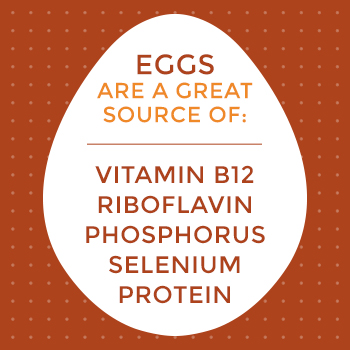
While the process of hard boiling an egg is fairly basic, there’s a science behind it. Figuring out the best way to hard boil eggs can take a bit of trial and error before you get it right. Surely, you don’t want to break into an egg with the hopes of savoring a runny yolk, only to find it completely solid. If you hate soft yolk, you’d be just as disappointed to see your egg undercooked.
Not to worry — here at Sauder’s Eggs, we’ve put together a guideline to help you boil your eggs perfectly, whether soft- or hard-boiled. You’ll also learn how to easily peel and properly store hard-boiled eggs.
How to Hard-Boil An Egg
The perfect boiled egg depends on your personal preference. If you already have a working system for boiling eggs for deviled eggs or egg salad or to have on hand as a grab-and-go snack, by all means, stick to it. The main factor in any egg boiling method is reliability. However, if you don’t have the method perfected, below are some tried-and-true suggestions.

Cold Start vs. Hot Start
For the “cold start” method, you take your eggs directly out of your refrigerator and stick them into a saucepan filled with cold water. Bring the eggs to a boil, and then turn your stove burner down to its lowest setting. The time you pull them out will depend on how soft- or hard-boiled you want them.
For the “hot start” method, you bring the water to a boil first and then lower the eggs in. The eggs should be cold and come directly from your refrigerator. Once you’ve added all the eggs to the boiling water, turn the burner down to a simmer. Again, the amount of time you boil them for will vary depending on how you want them cooked.
Ice Bath
Regardless of time spent boiling, place the eggs in an ice bath immediately after taking them out of the pot of water. Allow them to sit in the ice bath for around 10 to 15 minutes. You’ll then take them out of the ice bath, crack them by tapping them on the edge of the bowl or against one another and then allow them to sit for a minimum of five minutes before you peel them.
For hard-boiled eggs, the length of time you let your eggs simmer after you place them in boiling water will depend on how hard you want them. Anything less than eight minutes will result in a gooey yolk. A good rule of thumb is:
- Boil for eight minutes if you’re looking for a completely set yolk but still want it a little golden and gooey.
- Boil for 10 minutes if you want a firmer pale yolk but still want it a little softer in the middle.
- Boil for 12 minutes if you want an almost fully hard-boiled yolk, but with a little gooey golden center.
- Boil for 14 minutes if you want a completely hard-boiled egg with a pale, dry and crumbly yolk.
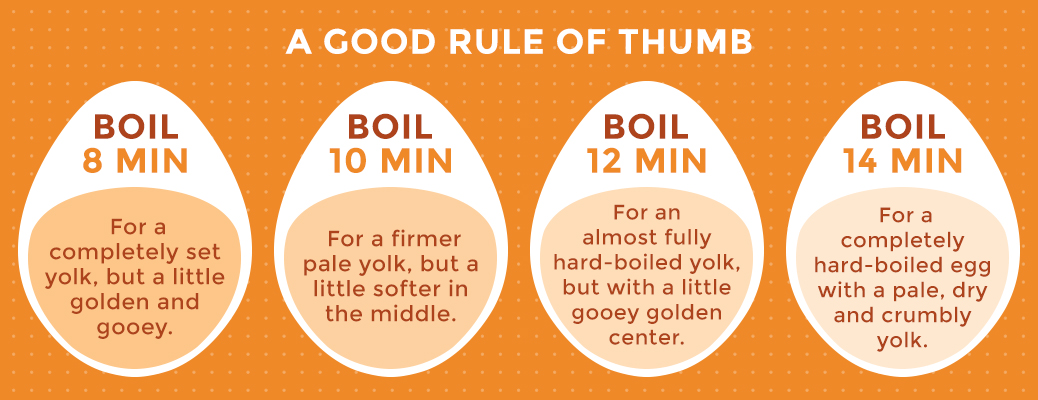
Once you get your perfect boiled-egg style down to a science, you can use any size saucepan or pot with as many eggs as you want and still get the same results. You just need to start off with cold eggs straight from your refrigerator, place them in the water (boiling or cold), turn the burner to a simmer and time the process.
Steps For The Perfect Hard-Boiled Eggs at Room Temperature
To begin the process, you’re not using cold eggs, but rather warming them up gently either by allowing them to sit out for 20 to 30 minutes at room temperature or warming them under hot tap water.
With this method, your eggs are less likely to crack while they’re in the water since you’ve brought them down to room temperature. Your cooking time will be a little different too since the eggs are room-temperature and not cold straight out of the fridge. The boil time will be around a minute less than fridge-cold eggs when starting the cooking process with room temperature eggs.
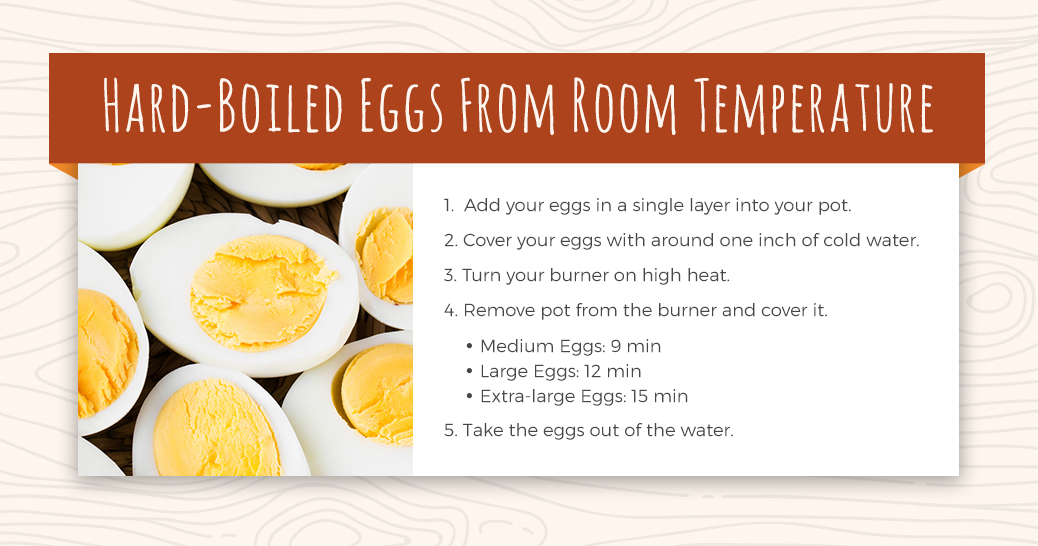
Use the four steps below to hard boil eggs when using this method so you’ll end up with golden-yellow yolks and tender whites.
- Add your eggs in a single layer into your pot. If you can’t get a single layer, you need a bigger pot.
- Cover your eggs with around one inch of cold water. You want the eggs submerged in water.
- Turn your burner on high heat. Heat the eggs until the water is just starting to boil.
- Remove pot from the burner and cover it. Allow your eggs to sit in the water for the following lengths of time:
- Medium eggs — Nine minutes
- Large eggs — 12 minutes
- Extra-large eggs — 15 minutes
- Take the eggs out of the water. Serve them warm or use cold running water to cool the eggs. You can also submerge them in an ice bath for several minutes. Refrigerate after.
Although this method requires you to get the water to a full boil, you immediately remove the pot from the burner, so you’re cooking your eggs gently in hot water. By preparing them this way, you produce eggs that aren’t rubbery, are tender and don’t crack.
Have you ever noticed a greenish ring on an egg after it boils? It’s an unattractive but harmless discoloration that sometimes forms around the yolks of hard-boiled eggs due to a reaction between iron in the yolk and sulfur in the white of the egg. This greenish ring tends to occur when you’ve cooked your eggs too long or at too high a temperature.
The method above minimizes the likelihood of the greenish ring since you’re not boiling your eggs, but rather cooking them in hot water and then cooling them down immediately after.
Difference Between Hard and Soft-Boiled Eggs
Hard-boiled eggs have solid yolks and whites. You can use them to make deviled eggs, slice them up as a quick protein snack or make Easter eggs out of them.
Soft-boiled eggs require a shorter cooking time, which gives them solid whites but softer yolks. You can add soft-boiled eggs in a hot bowl of ramen noodles, on top of a salad or for breakfast with dunk-able “soldier” toast strips.
- A hard-boiled egg is the perfect on-the-go, protein-packed snack.
- A soft-boiled egg turns your morning English muffin or bagel into a delicious breakfast complete with a special “built-in” runny yolk sauce.
Benefits of the Hard-Boiled Egg
A hard-boiled egg is easier to get out of its shell. You may dice, slice or cut these eggs and eat them by themselves, turn them into an egg-salad sandwich or add them to salads and other food preparations. Bring them along when traveling or on picnics without having to worry about them getting mashed up and turning into a runny mess inside your bag or on your clothing.
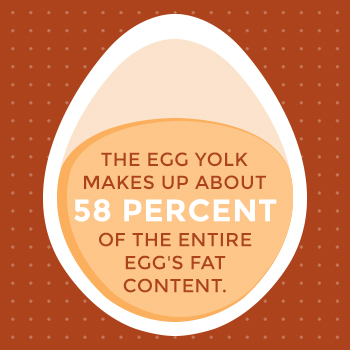
The egg yolk makes up about 58 percent of the entire egg’s fat content. With a hard-boiled egg, you can easily remove the yolk and eat just the white of the egg if you’re watching your weight. Doing so will reduce your calorie intake and still satisfy your protein requirements. You can’t easily remove the yolk of a soft-boiled egg.
Benefits of the Soft-Boiled Egg
Egg whites have protein in them which, when combined with the yolk’s biotin, can prevent absorption. Biotin is vitamin B7, a water-soluble B vitamin. It assists your body in converting food into energy. When you boil eggs, this egg-white protein can’t bind to the yolk’s biotin. High heat sabotages biotin and destroys it. Boiling eggs also damages the lecithin efficacy in the yolk. Lecithin keeps your cholesterol under control.
The white of a soft-boiled egg is silken and almost melts in your mouth. When you hard boil an egg in boiling water, the white of the egg becomes rubbery.
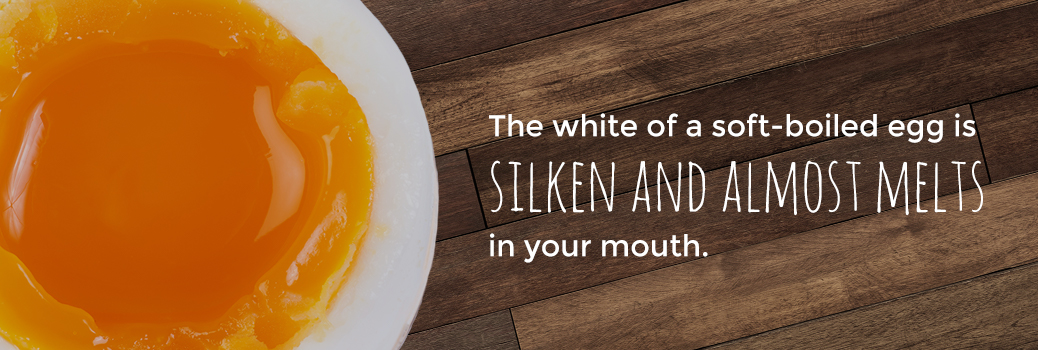
Keep in mind, however, that with soft-boiled eggs, there’s still a risk of Salmonella bacteria surviving in the yolk. Therefore, you should avoid giving children soft-boiled eggs. It’s also harder to mix soft-boiled eggs with foods like salads since the eggs are runny. Some people like soft-boiled eggs, however, since they’re getting the full nutrition of the egg and a creamy taste. Runny yolks make a great dip.
Temperature Differences for Cooking Eggs
When you have a good understanding of how ingredients work, you’ll have far better control over your food during cooking. Cooking eggs comes down to temperature and time. Here’s a temperature reference to help you when cooking eggs:
- Temperatures at 145 degrees Fahrenheit start the thickening process of egg whites.
- Temperatures at 150 degrees Fahrenheit start the thickening process of yolk proteins. Egg whites start becoming solid.
- Temperatures at 158 degrees Fahrenheit cause the egg yolks to set.
- Temperatures at 165 degrees Fahrenheit cause the entire egg to set.
Cooking eggs at 212 degrees Fahrenheit or higher for too long will make them rubbery.
Egg whites contain forty different proteins — they have 12 percent ovotransferrin and 54 percent ovalbumin. Temperatures at 180 degrees Fahrenheit cause ovalbumin to begin setting while temperatures of 140 degrees Fahrenheit cause ovotransferrin to start setting. A temperature of 158 degrees Fahrenheit will cause the lipoproteins in egg yolks to begin coagulating.
Nutritional Value
One large hard-boiled egg has about 78 calories and 6.3 grams of protein. It offers six percent of the recommended dietary allowance (RDA) of folate, seven percent vitamin D RDA, eight percent Vitamin A RDA and 23 percent Vitamin B12 RDA. Regardless of how you cook your eggs, these essential nutrients stay pretty much the same. The yolk contains most of the vitamins and minerals of the egg while the whites provide most of the magnesium and potassium. Both the yolk and white of the eggs have high concentrations of phosphorus.
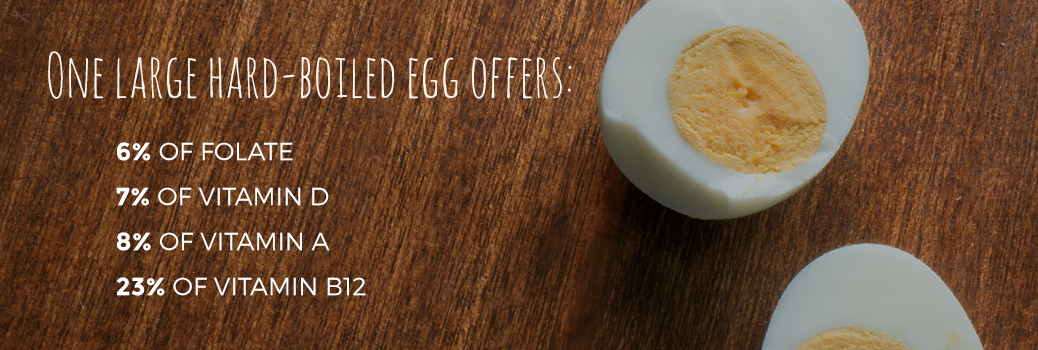
The main benefit of hard boiling your eggs over soft boiling is that hard-boiled eggs have less of a risk of Salmonella. Cooking temperatures higher than 150 degrees Fahrenheit kill Salmonella, so you could argue that cooking your eggs longer is healthier.
Fortunately, there’s a low chance of an egg having Salmonella-bacteria contamination (around one in 20,000 eggs are contaminated). However, you still shouldn’t take any chances of contracting foodborne illnesses. You can reduce your risk by handling your eggs properly and cooking them thoroughly until the yolks and whites are firm.
Trickiness of Cooking
You may think cooking a soft-boiled egg involves the same process as cooking a hard-boiled egg, but for less time, right? Not exactly true. Boiling your eggs with a hot start or cold start makes a difference since it’s easier for you to tell how long you’ve been boiling an egg when you add it to already-boiling water instead of bringing it up from cold. You need exact timing when you’re trying to make eggs with solid whites and runny yolks.
The difference between a hard-boiled and soft-boiled egg is a matter of mere minutes. You need to time them right, or you could end up with an overcooked egg that has a gray-looking yolk.
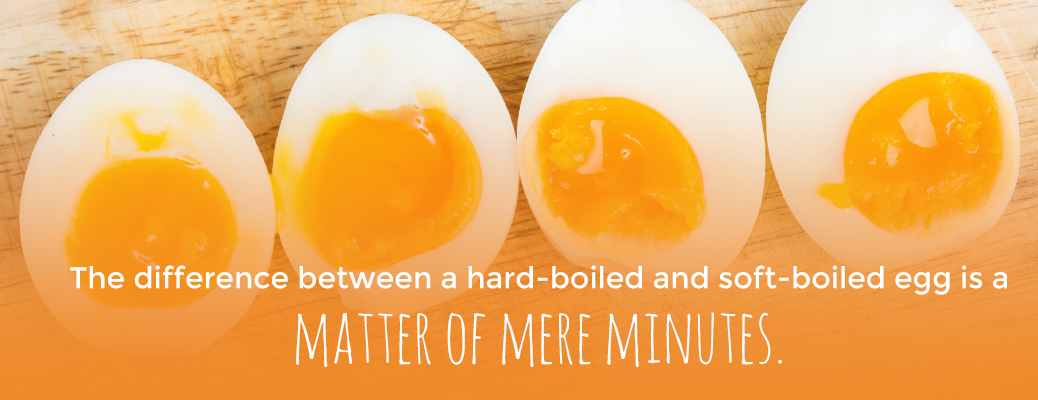
Boiling Hard-Boiled Eggs
Try placing your eggs in a small pot and covering them with around an inch of water. Then, bring the water to a boil, remove the pot from the burner, cover it and let the eggs sit for six to 12 minutes depending on what style of egg you’re going for.
Boiling Soft-Boiled Eggs
With soft-boiled eggs, bring your water to a light boil and then add the eggs gently, but quickly, into the water. Cover the pot, turn the heat off and let the eggs sit for about four to six minutes. Then, take the eggs out of the water and put them narrow-side-up into an egg cup. Serve them immediately.
Serving Options of Hard-Boiled Eggs
Hard-boiled eggs give you a lot of options. Create nutritious and delicious snacks and meals with them. Serve them with savory dips, spicy herb blends or cut up to complement a meal. You can dice and slice them or cut them up into wedges to tuck into sandwiches, wraps or top salads. Pair them with fruits and veggies to complete your satisfying meal.
Add flavor and color to any dish whether its grains, toast, bowls of ramen or salads. As soon as you’ve gone past the eight-minute boiling mark, you have endless possibilities.
How to Peel a Hard-Boiled Egg
Peeling fresh eggs can be challenging. To make it easier, refrigerate your hard-boiled eggs for about a week after purchase before you cook them. You can safely refrigerate your hard-boiled eggs up to a week when they still have their shells on them. Prevent them from absorbing odor by returning them to the carton they came in. Waiting also gives the eggs a “breather” period, allowing them to absorb air that helps separate the shell from the membranes.
In fresh eggs only a couple of days old, the membrane under the shell tightly sticks to the shell and makes it almost impossible to peel off. Eggs become easier to peel once they’ve been in the fridge for a few days. What’s the reason? The albumen in fresh eggs sticks to the membrane of the inner shell more tightly than it sticks to itself since the egg has an acidic environment. A fresh egg has a white with a pH around 7.6 to 7.9 and a cloudy, opalescent appearance because of carbon-dioxide presence.
Once you wash the protective coating off the shell of the egg, it starts to get porous and absorb air, losing some of the albumen’s carbon dioxide. This decreases the egg’s acidity, which creates a 9.2 pH after several days’ refrigeration. The higher the pH becomes, the less the inner membranes stick and the easier it gets to peel the egg. Also, as the egg ages, it shrinks, and the air space between the membrane and eggshell grows.
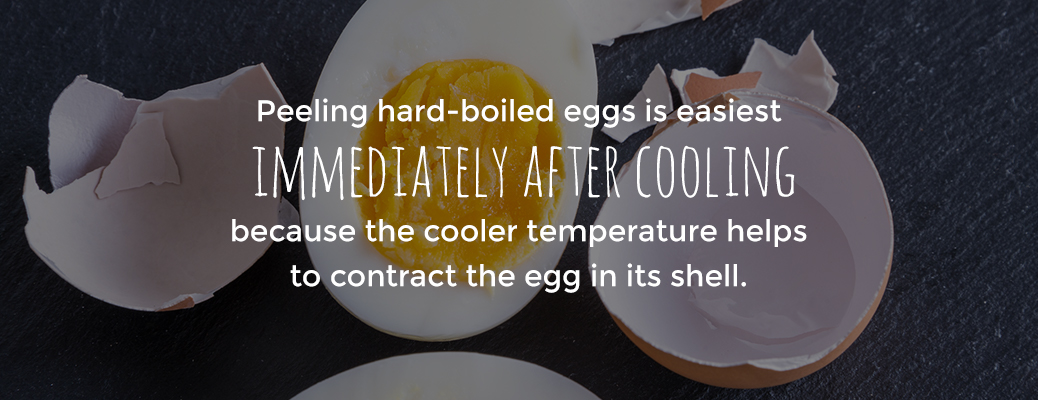
Peeling hard-boiled eggs is easiest immediately after cooling because the cooler temperature helps to contract the egg in its shell. To make it even easier to peel your eggs, place them into an ice bath right after you’ve boiled them. Allow them to sit for a while and then take them out, crack them by tapping them and give them a moment before peeling.
Here’s a good step-by-step method of peeling hard-boiled eggs:
- Hard boil your eggs: Hard boil your eggs correctly to ensure easy peeling. Add them to boiling water instead of room-temperature water to help cleanly release them from their shells. Take your eggs directly from your fridge — don’t let them get to room temperature first from sitting on your countertop for a while. Cook them for at least nine minutes.
- Drain your eggs and place them in cold water or an ice bath: Once you finish boiling your eggs, put them in cold water or a bowl of ice water.
- Swirl eggs in water: Swirl your eggs gently in the cold water in the pot. Use a circular motion so they start crashing into each other — think bumper cars. The shells begin slightly cracking in the process.
- Tap your eggs: Begin tapping your eggs on the edge of the pot or your counter to finely crack them all over. Loosen the shell by rolling the egg between your hands.
- Start peeling: Begin peeling your eggs at the large end as you hold them under cold running water. Once most of the shell is off, take your thumb and begin running it around the egg and under the shell. The shell should peel off with little to no effort. To ensure all remaining shell bits are off your eggs, return them to the water and wash them off.
How to Store a Hard-Boiled Egg
To prevent your hard-boiled eggs from spoiling, you need to store them properly. While you destroy Salmonella during the cooking process, the shells are still vulnerable to bacteria and odors. When storing your eggs, you can take necessary precautions to greatly reduce the risk of spoiling them.
Potential bacteria will have fewer chances of multiplying the quicker you use your eggs. Eggs rarely spoil when you handle and store them correctly. Keeping hard-boiled eggs (shell or no shell) out at room temperature is not safe. Keep eggs cool when serving them on a buffet or taking them to a picnic.
You have to refrigerate hard-boiled eggs at all times. Store them in a tightly closed container in your fridge to keep out contaminants and moisture.
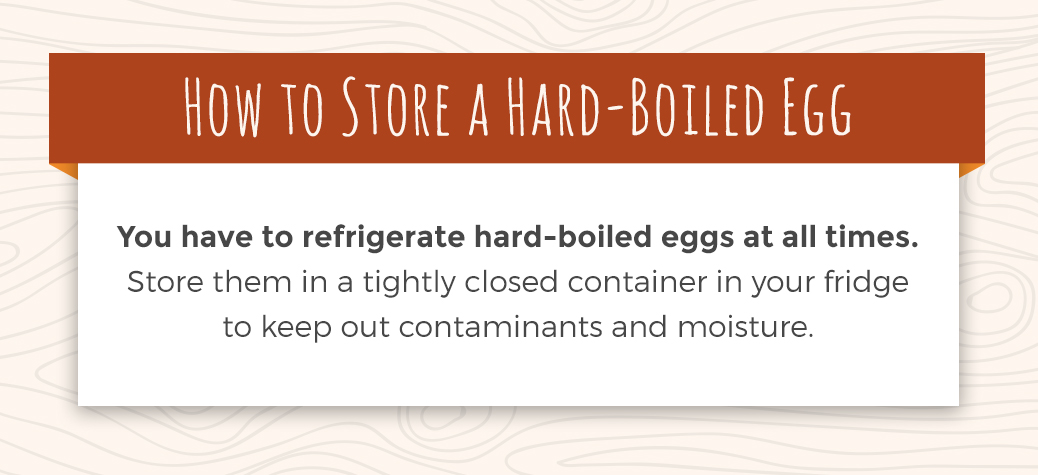
Three-Step Method for Storing Hard-Boiled Eggs
Properly storing your hard-boiled eggs is as easy as three steps:
- Stop the cooking: Remove the pot of water and eggs from the burner once you cook your eggs thoroughly. Drain the water from the pot and refill it with cold water, which stops your eggs from cooking and begins the cooling process. Completely cool your eggs, but don’t let them sit for more than an hour or two tops at room temperature.
- Package shelled eggs: Place your hard-boiled eggs in a covered container or back in their carton. Put them in the fridge once they’re cooled. Don’t store them for more than a week.
- Submerge peeled eggs: If you decide to peel your eggs before you store them, put them in a big bowl of water and ensure you completely submerge them. Change the water every day and use the eggs within seven days.
Peel or Shell On
It’s up to you whether you keep the shell on your eggs or peel them. If you’re using the eggs for your salad at dinner or making deviled eggs, take off the shell once the eggs cool. Store them in the fridge for no more than seven days regardless of whether you peel them or not.
Storing Shelled Eggs
If you do decide to keep the shells on your eggs, store them in a small bowl or the cooking pot. You can also put them back in their original carton to save space — just be sure you mark them to identify they’re your hard-boiled eggs.
You shouldn’t store your hard-boiled eggs in the freezer since it can reduce their shelf life and destroy their cellular structure. Whether you boil them or not, you shouldn’t freeze eggs to store them — egg whites become discolored and rubbery after you freeze and thaw them.
Like other dairy products, eggs don’t typically have a “use-by” date. Instead, they have a “sell-by” date. Due to this distinction, you can use your boiled eggs safely even after the sell-by date or best-by date has lapsed.
Get to Know Sauder’s Eggs
Whether soft-boiled or hard-boiled, eggs contain essential nutrients and vitamins making them an excellent, healthy choice for breakfast, snacks, lunch and even dinner. Get creative with your eggs, but remember to practice safety with handling and storing them.
Here at Sauder’s Eggs, we are proud to provide top-quality eggs to consumers from Pennsylvania and Maryland to Ohio and other locations. To find a store near you carrying Sauder’s Eggs or to sign up for our newsletter, complete our store-locator form.
